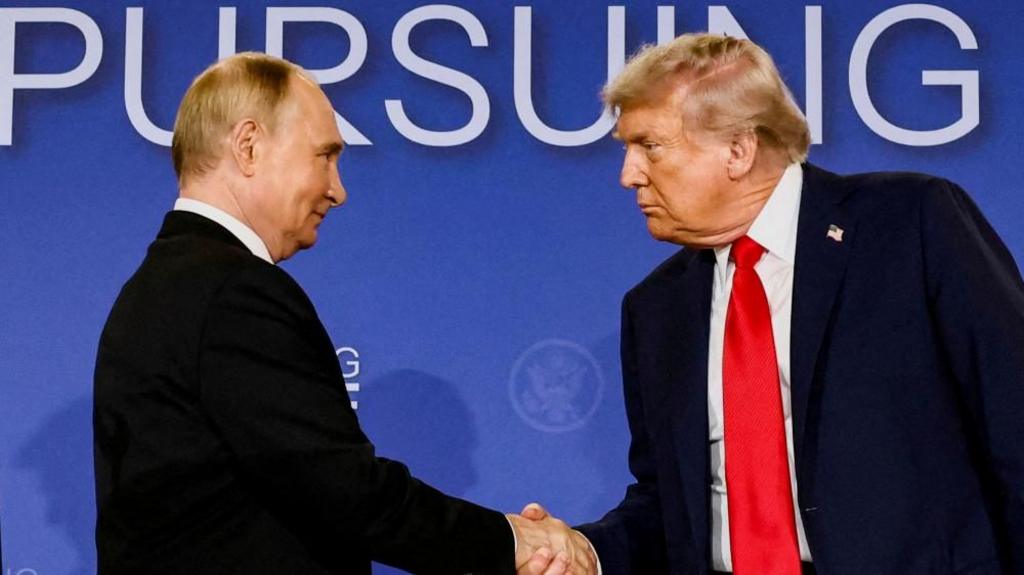Reports of a potential US-Russia summit appear to have been premature.
Just days after US President Donald Trump indicated plans to meet with Russian President Vladimir Putin in Budapest “within two weeks or so,” the summit has been indefinitely postponed.
A preliminary meeting between the two nations’ top diplomats has also been cancelled.
“I don’t want to have a wasted meeting,” President Trump told reporters at the White House on Tuesday. “I don’t want to have a waste of time, so I’ll see what happens.”
This now-suspended summit marks the latest development in Trump’s efforts to facilitate an end to the conflict in Ukraine – a matter that has received renewed attention from the US president following a ceasefire and hostage release agreement in Gaza.
While delivering remarks in Egypt last week to celebrate the ceasefire agreement, Trump tasked Steve Witkoff, his lead diplomatic negotiator, with a new objective.
“We have to get Russia done,” he stated.
However, replicating the circumstances that enabled the Gaza breakthrough for Witkoff and his team may prove challenging in the context of the Ukraine war, which is nearing its fourth year.
According to Witkoff, a key factor in securing the Gaza deal was Israel’s decision to target Hamas negotiators in Qatar, a move that angered America’s Arab allies but provided Trump with leverage to pressure Israeli Prime Minister Benjamin Netanyahu into an agreement.
Trump capitalized on a long-standing record of support for Israel, dating back to his first term, including the relocation of the US embassy to Jerusalem, a shift in US policy regarding the legality of Israeli settlements in the West Bank, and recent support for Israel’s military actions against Iran.
In fact, the US president enjoys greater popularity among Israelis than Netanyahu – a dynamic that afforded him significant influence over the Israeli leader.
Coupled with Trump’s political and economic ties to key Arab players in the region, he possessed substantial diplomatic leverage to compel an agreement.
In contrast, Trump has considerably less leverage in the Ukraine war. Over the past nine months, he has fluctuated between attempts to exert pressure on both Putin and Zelensky, seemingly to little avail.
Trump has threatened to impose new sanctions on Russian energy exports and supply Ukraine with advanced long-range weaponry. However, he has also acknowledged the potential for such actions to destabilize the global economy and further escalate the conflict.
Furthermore, the president has publicly criticized Zelensky, briefly suspending intelligence sharing and arms shipments to Ukraine, only to reverse course in response to concerns from European allies who warned that a Ukrainian collapse could destabilize the entire region.
Trump frequently emphasizes his ability to negotiate and finalize agreements, but his face-to-face meetings with both Putin and Zelensky have not appeared to bring the war any closer to resolution.
It is possible that Putin is leveraging Trump’s desire for a deal – and his belief in the efficacy of in-person negotiations – as a means of influencing him.
In July, Putin agreed to a summit in Alaska just as Trump appeared poised to approve a congressional sanctions package supported by Senate Republicans, legislation that was subsequently put on hold.
Last week, amid reports that the White House was seriously considering sending Tomahawk cruise missiles and Patriot anti-air systems to Kyiv, the Russian leader contacted Trump, who then promoted the idea of a potential summit in Budapest.
The following day, Trump hosted Zelensky at the White House, but reportedly emerged from a tense meeting without securing any commitments.
Trump insisted that he was not being manipulated by Putin.
“You know, I’ve been played all my life by the best of them, and I came out really well,” he asserted.
However, the Ukrainian leader later commented on the sequence of events.
“As soon as the issue of long-range mobility became a little further away for us – for Ukraine – Russia almost automatically became less interested in diplomacy,” he observed.
Thus, within a matter of days, Trump has shifted from considering sending missiles to Ukraine to planning a summit with Putin in Budapest and privately urging Zelensky to relinquish all of Donbas – including territory that Russia has been unable to capture.
He has ultimately settled on advocating for a ceasefire along the existing battle lines – a proposal that Russia has rejected.
During his campaign last year, Trump promised to end the Ukraine war within hours. He has since retracted that pledge, acknowledging that resolving the conflict is proving more difficult than anticipated.
This marks a rare admission of the limitations of his power – and the challenge of establishing a framework for peace when neither side is willing, or able, to concede defeat.
This is the eighth US strike on alleged drug trafficking vessels near Latin America, the first on the Pacific side.
The American was taken from an area near the presidential palace in Niamey, Niger.
Shares in the struggling plant-based meat company have rallied as retail traders pile onto stock.
The US government shutdown is now in its third week and shows no sign of ending soon. Here is where things stand.
Democratic candidate Graham Platner says he was unaware that his skull-and-crossbones tattoo looked like Nazi imagery.

